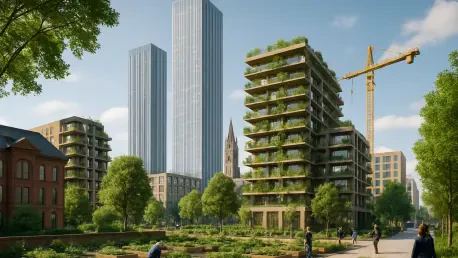Today, we’re thrilled to sit down with Luca Calarailli, a renowned expert in construction, design, and architecture, whose passion for integrating technology into the industry has made him a leading voice in urban development. With a deep understanding of how cities grow and thrive, Luca is here to unpack Manchester’s exciting share of the £1 billion Greater Manchester Good Growth Fund. In this conversation, we’ll dive into the transformative potential of nearly £200 million in investments, exploring how this funding will reshape housing, boost affordability, and drive commercial innovation in key areas of the city. We’ll also touch on how these initiatives align with Manchester’s broader ambitions for economic growth and community development.
How does the Greater Manchester Good Growth Fund aim to transform urban spaces, and what role does Manchester play in this regional vision?
The Greater Manchester Good Growth Fund is a bold initiative designed to fuel sustainable growth across the region, with a focus on economic vitality, job creation, and housing solutions. It’s a £1 billion commitment to ensure that growth benefits everyone, not just a select few. Manchester, as a central hub, is receiving nearly £200 million of this investment, positioning it as a key driver of regional progress. The city’s projects under this fund are geared toward creating vibrant communities through new homes and commercial spaces, while also addressing critical needs like affordability and innovation. Manchester’s role is pivotal—it’s not just about growth for the city itself, but about setting a standard for the entire Northwest.
What are the core objectives behind Manchester’s allocation of nearly £200 million from this fund?
The primary goals for Manchester’s share are twofold: to supercharge economic growth and to meet pressing social needs. On the economic side, the funding targets high-growth sectors like innovation and technology, creating jobs and opportunities for local residents. On the social front, it’s about building over 1,500 new homes with a strong emphasis on affordability, ensuring that growth doesn’t leave people behind. This investment also supports transformative commercial projects that will attract businesses and talent, while reinforcing Manchester’s status as a world-class city. It’s a balance of ambition and responsibility—growth that works for everyone.
How is the fund addressing the housing crisis in Manchester, particularly with a focus on affordability?
Housing is a cornerstone of this investment, with over 1,500 new homes planned across key regeneration areas. The focus on affordability is critical—many of these homes are designed to be genuinely accessible to local residents, whether through social rent or capped pricing models. Areas like Victoria North, the Northern Quarter, and Wythenshawe Town Centre are seeing targeted developments that prioritize community needs over profit. This isn’t just about numbers; it’s about creating sustainable neighborhoods where people can afford to live and thrive, aligning with Manchester’s broader goal of building 36,000 homes by 2032, including 10,000 affordable or social units.
Can you elaborate on what ‘genuinely affordable’ means in the context of the 622 homes planned for Victoria North, and how this will benefit the community?
In Victoria North, ‘genuinely affordable’ means that at least 20% of the 622 new homes will be priced or rented at rates that align with local income levels, rather than market-driven costs. This often involves subsidies or partnerships to keep costs down, ensuring that families and individuals who might otherwise be priced out can stay in the area. The impact on the community is significant—it prevents displacement, fosters diversity, and builds stability. Residents get access to quality housing without the burden of unaffordable rents or mortgages, which in turn strengthens the social fabric of this regenerating neighborhood.
In the Northern Quarter, there’s a development of 126 homes at Postal Street with some rents capped at the Manchester Living Rent. Can you explain what this cap entails and who it’s meant to help?
The Manchester Living Rent is a benchmark designed to make housing costs manageable for average earners in the city. For the Postal Street development in the Northern Quarter, at least 20% of the 126 homes will have rents tied to this standard, which is typically linked to local wages rather than inflated market rates. This cap is aimed at helping working individuals and families—think teachers, nurses, or retail workers—who often struggle with city-center living costs. It ensures they can afford to live close to where they work or enjoy the cultural vibrancy of areas like the Northern Quarter without financial strain.
Turning to Wythenshawe Town Centre, over 400 new homes are planned, including ‘extra care’ flats. What kind of support do these flats provide, and who are they intended for?
The ‘extra care’ flats in Wythenshawe Town Centre, part of the over 400 new homes, are designed for older adults or individuals with specific health or mobility needs who want to maintain independence but require some level of support. These flats often include on-site care services, emergency response systems, and accessible design features. They’re meant to bridge the gap between fully independent living and residential care homes, allowing residents to stay in their community with tailored assistance. This is especially important for aging populations or those with disabilities, ensuring they’re not isolated and can access both housing and care in one place.
Looking at the bigger picture, how does this funding advance Manchester’s ambitious target of 36,000 homes by 2032, with a focus on affordable and social housing?
Manchester’s goal of 36,000 homes by 2032, with 10,000 being affordable or social housing, is a massive undertaking, and this funding is a significant catalyst. The £200 million directly supports projects that contribute to these numbers, particularly in areas like Victoria North and Wythenshawe, where affordability is a priority. Beyond just adding units, the fund helps accelerate timelines, secure partnerships, and ensure quality and sustainability in construction. It’s a crucial step toward meeting the city’s housing demand while addressing inequality—making sure that growth includes homes for all income levels, not just the well-off.
Shifting to commercial developments, why is the £44 million refurbishment of the old Kendals building on Deansgate for office space such a significant project for Manchester?
The refurbishment of the historic Kendals building on Deansgate into 450,000 square feet of office space is a game-changer for Manchester’s city center. This £44 million investment taps into the huge demand for high-quality office accommodation, which is critical for attracting businesses and talent. It’s not just about creating space; it’s about preserving a landmark while repurposing it for modern needs, blending heritage with economic vitality. This project signals to investors that Manchester is serious about growth, and it supports the city’s role as a regional economic engine, benefiting not just Manchester but the broader Northwest.
The fund allocates £20 million to expand SISTER, a global innovation hub. What types of industries or businesses stand to gain from this new office and lab space?
The £20 million expansion of SISTER is all about cementing Manchester’s place as a leader in cutting-edge industries. This global innovation hub will provide new office and lab space specifically for sectors like advanced manufacturing, materials science, life sciences, low-carbon technologies, and digital tech. Think startups and scale-ups working on sustainable solutions, biotech firms developing new treatments, or tech companies pushing digital boundaries. This investment creates an ecosystem where these high-growth businesses can collaborate, innovate, and access resources, ultimately driving job creation and positioning Manchester as a global player in innovation.
Another £22.1 million is going toward lab space on Upper Brook Street near the Oxford Road Corridor. How does this enhance Manchester’s status as a center for knowledge and research?
The £22.1 million for 81,000 square feet of lab space on Upper Brook Street is a strategic move to bolster Manchester’s Knowledge Quarter along the Oxford Road Corridor, which is already renowned for its concentration of universities, research institutions, and hospitals. This new space will support advanced research and development, likely in fields like health sciences and technology, fostering collaboration between academia and industry. It enhances Manchester’s reputation as a hub where groundbreaking ideas are born and tested, attracting global talent and investment. It’s about building on an existing strength to keep the city at the forefront of discovery and innovation.
What is your forecast for the long-term impact of the Greater Manchester Good Growth Fund on Manchester’s urban and economic landscape?
I’m incredibly optimistic about the long-term impact of this fund on Manchester. Over the next decade, I foresee a city that’s not only economically stronger but also more inclusive, with thousands of new, affordable homes ensuring that growth doesn’t come at the expense of community. The commercial investments, from office spaces to innovation hubs, will likely solidify Manchester’s position as a magnet for global businesses and talent, particularly in tech and research. If executed well, this fund could be a model for balancing economic ambition with social good, creating a city that’s both a powerhouse and a place where everyone has a stake in the future. I expect Manchester to become a benchmark for sustainable urban development across the UK and beyond.









